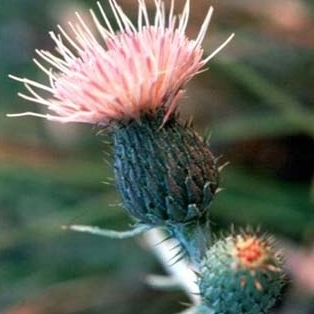Biennials or short-lived monocarpic perennials, 20–100 cm; taproots long. Stems 1 or few, erect, densely gray-tomentose; branches 0 to several, ascending to spreading. Leaves: blades elliptic to obovate, 10–30 × 8–14 cm, deeply divided nearly to midveins, lobes ascending to spreading, linear, remote, margins revolute, entire or minutely spinulose, main spines 1–2 mm, faces gray-tomentose, more densely so abaxially; basal present or withered at flowering, petiolate; principal cauline well distributed, bases decurrent as linear-lobed to spiny wings 1–3 cm; distal cauline well developed. Heads 1–20+ in corymbiform arrays. Peduncles 0–5 cm. Involucres ovoid to campanulate, 2–3 × 2–3 cm, loosely arachnoid on phyllary margins or glabrate. Phyllaries in 6–8 series, imbricate, ovate-lanceolate (outer) to linear-lanceolate (inner), abaxial faces with narrow glutinous ridge; outer and middle appressed, acute, spines ascending to spreading, slender, 1–2(–3) mm; apices of inner often flexuous, flattened, spineless, scabrid. Corollas dull white or pinkish-tinged (rarely rich purple), 20–30 mm, tubes 8.5–15 mm, throats 4.5–10 mm, lobes 3–8 mm; style tips 3.5–5.5 mm. Cypselae light brown, sometimes with darker streaks, 6–7.5 mm, apical collars lighter colored, very narrow; pappi 15–30 mm, usually noticeably shorter than corolla. 2n = 34.
More
Taprooted biennial or monocarpic perennial, 5–10 dm; stem and lower lf-surfaces densely and persistently white-tomentose, the upper lf-surfaces more thinly so; lvs deeply pinnatifid, with narrow rachis and long, remote, linear, entire or few-toothed, weakly spine-tipped lobes to 8 cm × 7 mm; heads several, white or whitish; invol 2.5–3 cm, its bracts slightly tomentose especially marginally, well imbricate, the inner long-acuminate, the others with weak spine-tip 1–2 mm; achenes 5–7.5 mm; 2n=34. Sand dunes around lakes Michigan and Huron and e. Lake Superior, in Ont., Mich., Wis., Ind., and formerly Ill. May–Sept.

